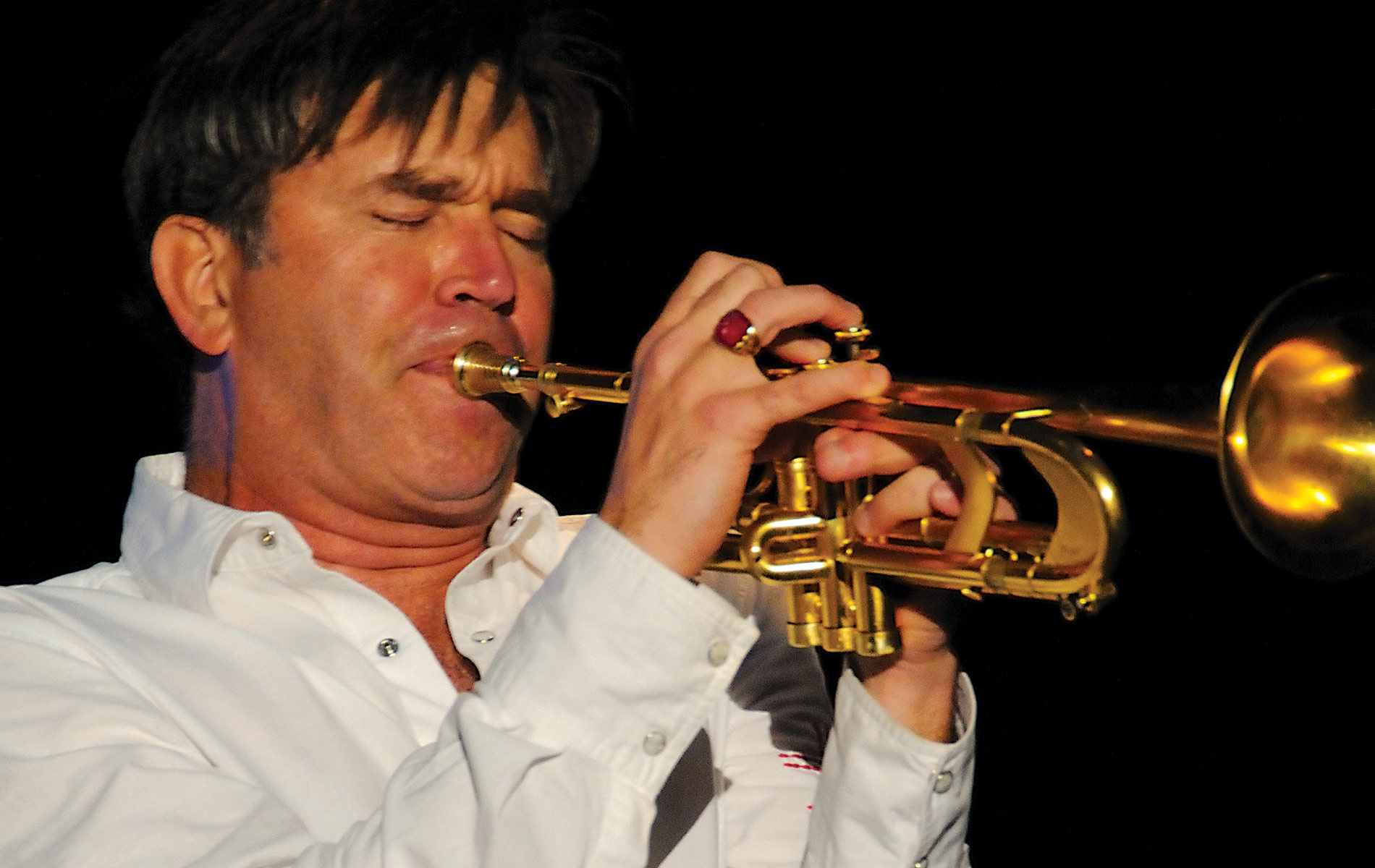
vie-magazine-jazz-fest
The Seabreeze Jazz Festival
By Jack Benner | Photography by Jessie Shepard
It was Sunday…they were tired…and who could blame them?
Several thousand strong, these diehards were sunburnt, bleary-eyed and just about played out. Not to mention sporting a mass case of tinnitus brought on by four days of amplified music. They had danced, partied, frolicked and otherwise made merry since Thursday. Now spread out across the green, they waited for one last act. As the sun set, many dozed while the sound crew assembled the drum set, rearranged monitors, plugged in microphones and ran sound checks. Finally, all was ready and the last of 24 acts in just under 96 hours took the stage.
Then, something amazing happened…
This crowd… this soporific gathering sprawled out across the acres of grass, who moments earlier lay nearly catatonic before the stage, came roaring back to life! They rose to their feet as one. They cheered! They danced!
There was one last party in them after all.
Now, before you start waxing nostalgic and telling stories about sneaking onto the Who’s tour bus and what a great time you had up on Max Yasgur’s farm, I should tell you, I’m not talking about 1969 at Woodstock. I’m talking about 2008 at Santa Rosa Beach, Florida. And it wasn’t even a rock concert. It was a jazz festival.
But this was no ordinary jazz festival.
This was the 10th Annual Seabreeze Jazz Festival, one of the top ten in America according to JAZZIZ Magazine, and an event that has set the world of Smooth Jazz on its collective ear.
“Wait a minute. Smooth Jazz? Are you talking about that elevator music?”
Only those who have never attended the Seabreeze Jazz Festival would ask that question. The lineup at Seabreeze is a virtual who’s who in the world of jazz, smooth jazz and music as a whole. This year’s lineup alone featured Dave Koz, Rick Braun, Richard Elliot, Joyce Cooling, Norman Brown and Brian Culbertson, just to name a few. And when these amazing musicians are released from the studio to take the stage in the warm April sun in Northwest Florida, a transformation occurs.
They ROCK the joint!
Don’t believe me? Just ask those in attendance. Ask about the Thursday night All-Star Jam that kicked off the four-day celebration of this uniquely American form of music. Talk to them about Saturday afternoon when Wayman Tisdale may have set a new world record by getting about 2,000 concert-goers dancing the electric slide… in perfect unison. And ask about the 4,000 people who hung around to the very end of the final day for a little R n R (that would be Rick Braun and Richard Elliot).
[double_column_left]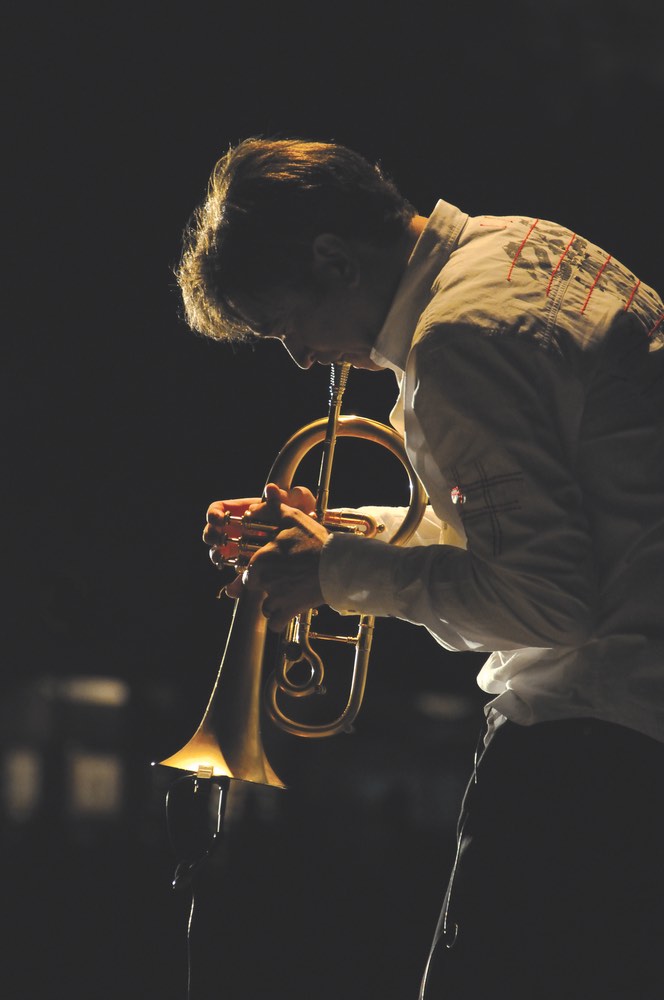
Rick Braun
Across the United States and around the world, hundreds of jazz festivals take place every year. The major market jazz festivals, such as Newport, Monterey and the Playboy Jazz Festival, tend to book more “straight-ahead” jazz acts like Herbie Hancock (although R n R played the Playboy event this year). One of the most popular is the New Orleans Jazz & Heritage Festival. This event draws tens of thousands, though the lineup recently has transcended jazz, moving into rock, urban, country and R&B. Then there are the lesser-known, smaller events like the Bix Beiderbecke Memorial Jazz Festival in Davenport, Iowa featuring acts like Spats Langham and his Rhythm Boys. (No, I didn’t expect you to know who they are. I just love the name “Spats.”)
[/double_column_right]With so many to choose from, how did the Seabreeze Jazz Festival become one of the nation’s top ten? And how did they do it in such a short amount of time? Playboy just held their 30th. Monterey is on number 51! How did Seabreeze do it in just ten?
The answer requires a little history of the festival.
In The Beginning
The Seabreeze Jazz Festival is the brainchild of husband and wife team Mark and Renee Carter. As owners of 106.3 The Seabreeze, a local radio station that plays smooth jazz, the original idea was more of a promotion for the station than an attempt to create an annual event of national prominence.
The very first Seabreeze Jazz Festival was held in March 1999 in SeaSIDE Florida (I emphasize the SeaSIDE because there has been a great deal of confusion between SeaSIDE and SeaBREEZE). It was, in a word, an intimate affair. That is to say, there were only about 350 people in the audience. A Saturday-and-Sunday-only event, there were two acts per day. The show started at 1:00 p.m. and was pretty much over by 5:00 p.m. Then, Renee would close the cashbox, round up their six kids and take everyone (musicians, workers, sound techs, everyone) down the road for a very nice meal at one of the local gourmet restaurants. This was to become a tradition, and one of many perks that had the jazz community buzzing about this little shindig down in the Florida Panhandle.
[double_column_left][/double_column_left] [double_column_right]“I am SO sorry! Really! It‘s never done this! I‘m sorry!”
Joyce Cooling to the sound crew while they tried to figure out why her guitar rig wasn’t working.
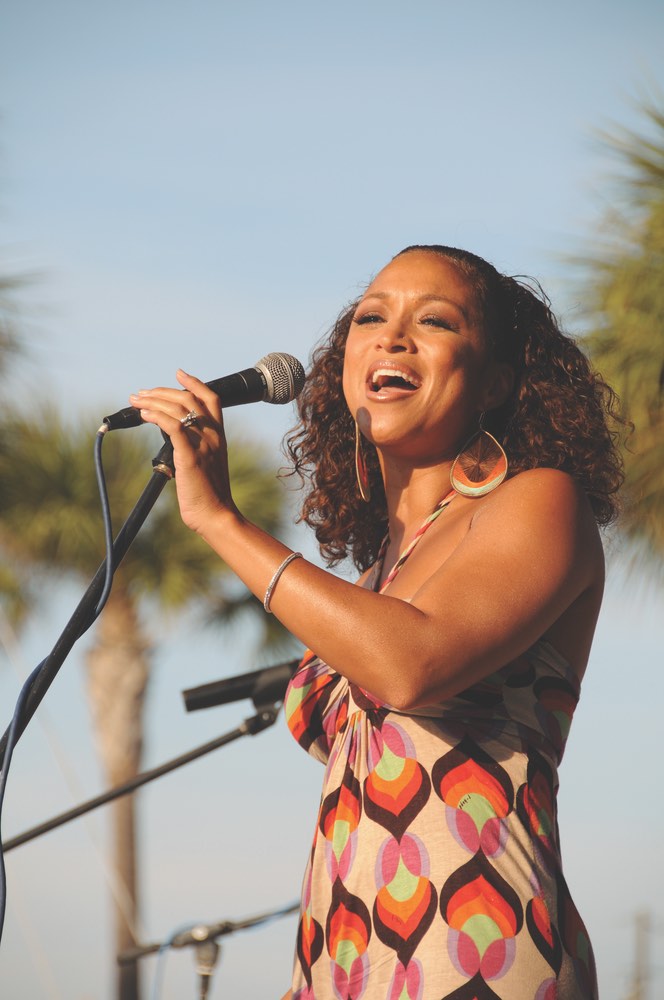
Joyce Cooling
Because, unlike the major market festivals, this one had a family feel to it. Road-weary musicians liked the fact that they were put up in Gulf-front condos instead of a typical chain hotel or motel. They enjoyed dining family style at top-rated restaurants as opposed to being handed a contract-mandated per diem and sent out to fend for themselves. And the hospitality wasn’t restricted to just the headliners. The band, the managers, the roadies… even the tour bus drivers were invited. It made the Seabreeze Jazz Festival a true family experience.
It hasn’t all been smooth sailing though. As radio personality and longtime festival host “Uncle” Harley put it, “Anytime you hold an event outdoors you have to keep one thing in mind: God has a sense of humor.” At the 2002 event, it rained…and rained…and rained, all night Friday and all day Saturday. By the time Saturday’s headline act (Rick Braun) took the stage, only about 200 very wet jazz fans remained. Braun played his first number and then took pity on the waterlogged assembly. He stepped up to the microphone and, much to the chagrin of the technical crew, said, “You people are CRAZY! Get on up here where it’s dry!” Somehow or another, most of them managed to shoehorn themselves on the stage with Rick and the band where they had the time of their lives.
By the way, Rick Braun bringing the audience up onstage is another Seabreeze Jazz Festival tradition.
Another year, a severe midnight thunderstorm, complete with funnel clouds, devastated the vendor tents along with thousands of dollars in sound equipment. Yet another festival saw the Carters and their crew racing to get all the acts on before a line of major storms hit the festival grounds. Not only did they pull it off, but they also managed to get everyone on the shuttle buses and safely on their way just before the sky fell.
“But we’ve always managed to pull it off,” Mark said. “It’s a rain-or-shine event, and we have always put on a show. I think it’s safe to say that everyone who has ever come, regardless of the weather, has enjoyed it.”
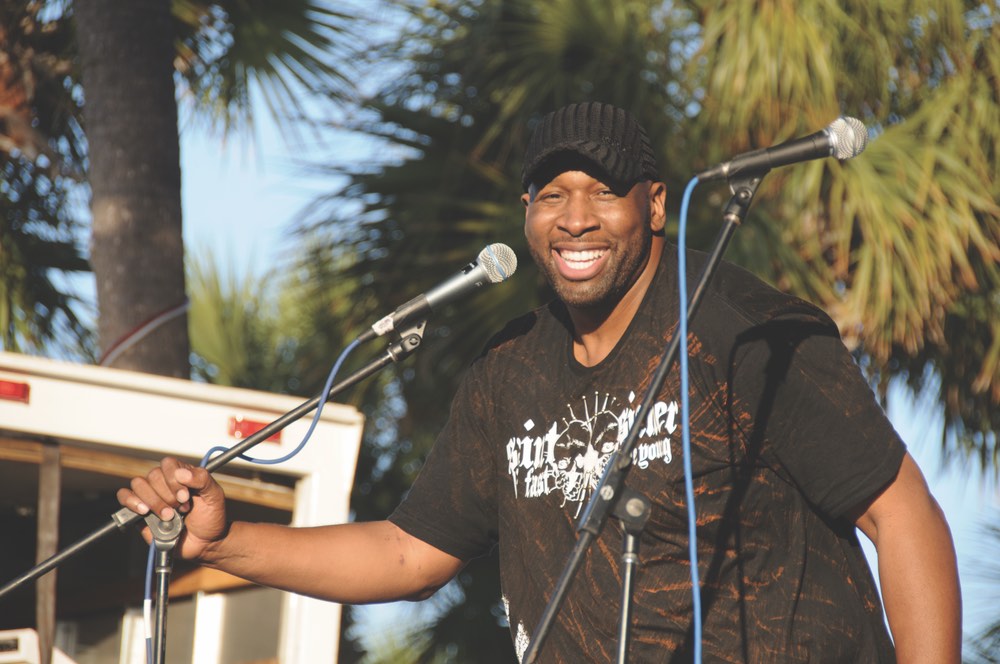
Waymon Tisdale
“Dang! You ever play basketball??”
Obviously clueless backstage security worker to 6’ 9” former NBA All-Star power forward and now jazz bassist extraordinaire Waymon Tisdale.
Making It All Happen
The logistics involved in putting together and executing a major musical event like this are staggering. Renee spends days on the phone in the weeks leading up to the festival working with managers and artists. “Some of these musicians are flying in just hours after their last performance… and that gig may have been in California or New York,” Renee explained. “We have to get them booked on the right flight at the right time to the right airport and have their limo idling at the terminal to get them to the stage in time to perform. Fail and you’ll have 5,000 VERY unhappy jazz fans.”
Then, there are the musicians themselves.
“They‘re wonderful. Salt of the earth,” Renee said. “They’ll stand around for hours signing CDs, shaking hands and posing for pictures.” (Accessibility to the artists is yet another tradition that makes the Seabreeze event different from so many others.) Renee continued, “I’ve watched Joyce Cooling sign autographs and smile for pictures ‘til I’m sure she had writer’s cramp and her cheeks ached.”
But surely there was someone that she could “dish” on. These are “show folk” after all. In ten years, there had to be at least one prima donna.
“Well… there was this one…” she began hesitantly. “I won’t name names, but his contract called for a monster stretch limo to be at his disposal.” That doesn’t sound all that unusual, I observed. She continued, “Yes, but his had to have a sushi chef in it.”
Now, I’m fairly sure that there’s no luxury car on the market that comes with a sushi chef…not even for the Sultan of Brunei.
But Renee is not quite done with this story. “Oh, it gets worse!” she declared. “He also hated the room at the hotel that his manager had specifically requested…against my advice. We had to scramble to find him an oceanfront house that he had to personally approve. Then, he didn’t spend a single minute in it. He stayed out and partied ‘til he flew out later that night.”
“But,” she added, “he really was the exception to the rule. Most of the artists are incredibly easy to get along with. Many have become friends.”
[double_column_left]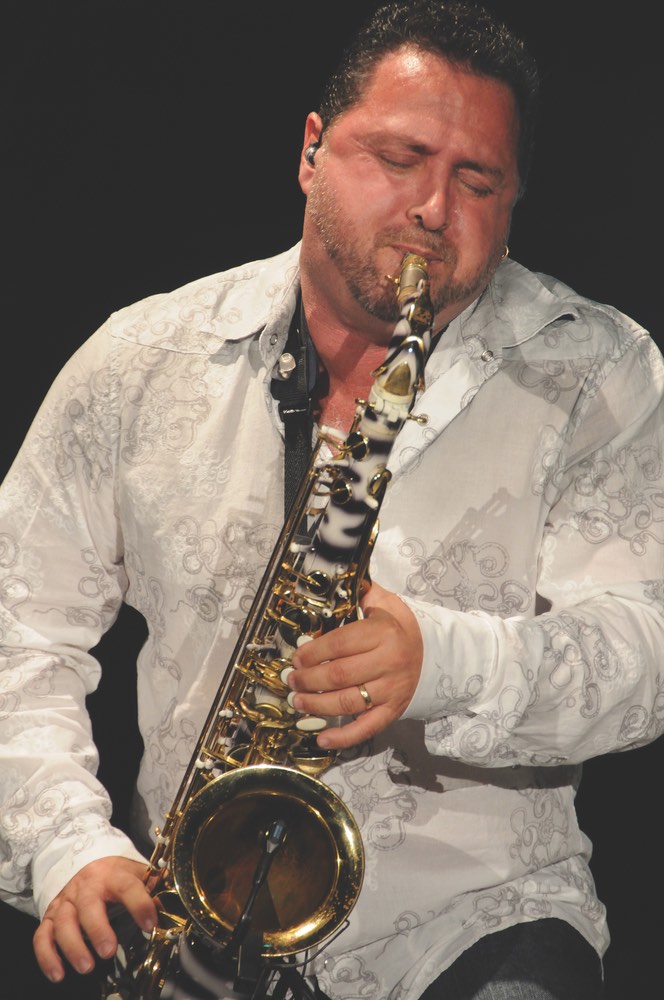
Richard Elliot
Once they arrive at the venue, the musicians are taken to the backstage area where they are handed over to Steve Pizza, owner of Pro Tech Sound, and Uncle Harley, who emcees the show. Steve and his crew have provided the increasingly elaborate stage and sound setup for the festival since the very beginning. Harley came on board the second year. The two also act in the capacity of stage co-managers. Working together closely, Steve and Harley are charged with keeping the show moving forward.
“There’s a huge difference between a concert and a festival,” Pizza explained. “At a concert you have one act… maybe a lead-in and then the main act. You have time for lengthy sound checks and set changes. But at this year’s festival, we had seven acts per day. That’s seven nationally charted recording acts. When one was done, we had to tear them down and set to work getting the next group ready to play. It‘s a real tightrope act… and the rope is time.”
[/double_column_right]Time is Harley’s department. “I’ll sit down weeks in advance with Steve, and we’ll hammer out a schedule that we think we can live with. It’s my job to post it backstage, get the managers and roadies on board with it and try to keep everyone on time. When you have a lineup as jam-packed as we did this year, plus curfews, noise ordinances and code enforcement sniffing around, you have to make sure that everyone is on the same clock. The artists are amazingly cooperative. But by the same token, there can be a whole ‘herding cats’ aspect to it as well. It’s a real challenge.”
The end result of all this planning, scheduling and just plain hard work was an almost flawless 10th anniversary show. Almost.
“There were a few minor glitches. But we have learned so much in ten years,” Mark explained. “About a week after every festival, we have what we refer to as the ‘post mortem.’ We sit and talk about what we did right, but mostly about where we can improve. That’s where we learn. That’s where we make it better and that’s how we progress year after year.”
Still, where has Seabreeze succeeded when others have failed? Harley thinks he may have the answer. “A lot of folks have looked at the festival the last few years and thought, ‘WOW! Look at all these people! I can do this!’ What they didn’t see were the early years. Mark and Renee started small and worked up. What you see today is the culmination of 10 years’ hard work. These people think that you can start with seven acts a day and 5,000 people. I think if we had tried that, we would have failed, too.”
The Next Generation
Nearly every musician at the festival has one thing in common… they got their start playing in the school band. In fact, not only did Brian Culbertson get his start in the school band, but his father was also the music teacher at his high school. Regardless of the instrument, be it sax, trumpet, keyboard or even voice, almost all their musical beginnings were in the classroom.
But with the advent of test-based curricula and the renewed focus on the “three R’s,” many schools have made deep cuts and even completely eliminated electives, such as shop classes, performing arts and, yes, even music.
This fact was not lost on Mark and Renee. As owners of a jazz radio station, founders of a jazz festival and parents to six children, they knew something had to be done. So they created their own charity, Music in the Schools. From the very beginning, a portion of the proceeds from the jazz festival have gone to this grass roots organization that to date has purchased uniforms, instruments, equipment and financed trips for local bands from elementary to the high school level. Recently, the Carters took it to the next level, handing the beer and wine concession over to be operated by the band parents, pumping thousands in much needed cash into the local schools’ band programs.
Taking it a step further, Mark and Renee have even enlisted the aid of artists appearing at the jazz festival. Some stay an extra day to go from school to school and stage music clinics for the kids.
“This is where the next generation is going to come from,” Renee explained. “If music programs are eliminated, where are tomorrow’s musicians going to come from? What would we do for the lineup for the 50th Annual Seabreeze Jazz Festival?”
[double_column_left]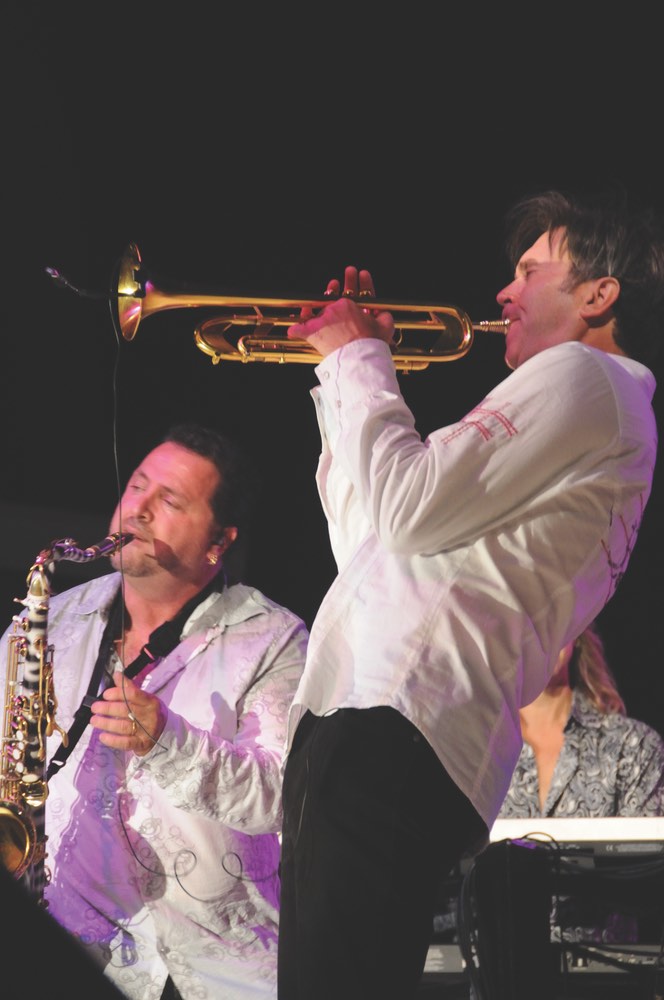
Richard Elliot & Rick Braun
Down The Road (Literally and Figuratively)
Over the years, the festival has had several homes. Starting with the first three years at Seaside, it moved four times in the next seven years. Because of the volatility of the real estate market (and the potential revenue to be made on beachfront property), the Carters could never get more than a one-year commitment from any acceptable venue. In fact, on more than one occasion, agreed upon arrangements were suddenly cancelled because of a spike in property values. “That was a huge problem,” Renee said. “We start planning for next year’s festival when our ears are still ringing from this year’s. Rooms have to be booked for the artists; workers permits, pulled; and parking, arranged, and the jazz fans need to know, so they can plan accordingly.”
So, what’s the solution?
[/double_column_right]“It looks as though our days as the gypsy jazz fest are over,” Mark said. “The 2009 festival is moving to The Pier Park Amphitheater in Panama City Beach. It’s got the beachy feel that the jazz fans like so much, great parking, close access to thousands of Gulf-front rooms and, best of all, the amphitheater is owned and operated by the city. That means we don’t have to worry anymore about whether someone will want to build a condo or strip mall there. We can sign a contract and be there for the next ten years. I think we’ve found a home!”
So what does the future hold for the Seabreeze Jazz Festival now that it’s found a new home? “The first year, we’re going to cap ticket sales at 5,500… just to see how it feels,” Renee said. “Then we’ll go from there. I don’t want it to get too big… to lose that intimacy. I don’t want to see the acts become a dot on the horizon.”
Mark summed it up nicely: “Give the fans the most bang for their buck and take care of the artists, and the rest will fall into place.”
That’s a formula that should keep the Seabreeze Jazz Festival in the top ten for years to come.
— V —
Share This Story!
KEEP UP WITH THE LATEST STORIES FROM VIE

































































































































